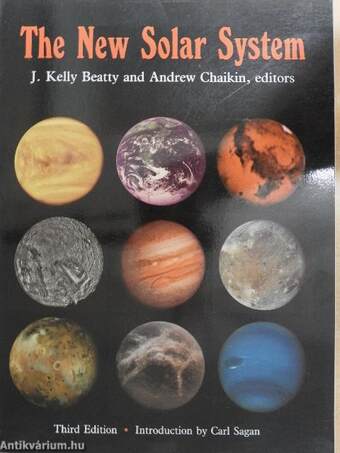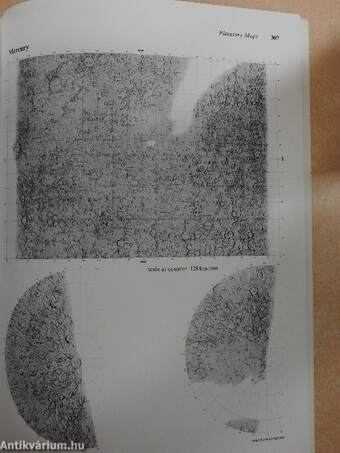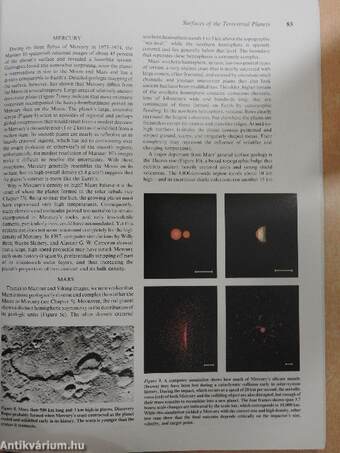1.119.677
kiadvánnyal nyújtjuk Magyarország legnagyobb antikvár könyv-kínálatát
The New Solar System
| Kiadó: | Cambridge University Press-Sky Publishing Corporation |
|---|---|
| Kiadás helye: | Cambridge |
| Kiadás éve: | |
| Kötés típusa: | Fűzött papírkötés |
| Oldalszám: | 326 oldal |
| Sorozatcím: | |
| Kötetszám: | |
| Nyelv: | Angol |
| Méret: | 28 cm x 21 cm |
| ISBN: | 0-521-36965-7 |
| Megjegyzés: | 3. kiadás. Fekete-fehér és színes fotókkal. |
naponta értesítjük a beérkező friss
kiadványokról
naponta értesítjük a beérkező friss
kiadványokról
Előszó
TovábbFülszöveg
Not that long ago, the solar system was an orderly collection of worlds that circled the Sun with clockwork regularity. There were "inner planets" made of rock and "outer planets" made of gas. Saturn had its rings and Jupiter its Great Red Spot. A score of little moons, a "belt" of asteroids, and an occasional comet completed the inventory.
But the Space Age has changed all that. In this glorious and historic era the worlds around us have been explored, not just passively observed. Our robotic emissaries have scouted out every planet except for Pluto. We have flown by and around them, dug into them, tasted their soils, sampled their atmospheres, and probed the electromagnetic bubbles that surround them. In fact, we have learned so much that it is possible to say - for the first time in human history - that we now grasp the outline, and many of the details, of how the Sun's family came to be and how its parts evolved.
No less successful have been astronomers back on Earth, whose... Tovább
Fülszöveg
Not that long ago, the solar system was an orderly collection of worlds that circled the Sun with clockwork regularity. There were "inner planets" made of rock and "outer planets" made of gas. Saturn had its rings and Jupiter its Great Red Spot. A score of little moons, a "belt" of asteroids, and an occasional comet completed the inventory.
But the Space Age has changed all that. In this glorious and historic era the worlds around us have been explored, not just passively observed. Our robotic emissaries have scouted out every planet except for Pluto. We have flown by and around them, dug into them, tasted their soils, sampled their atmospheres, and probed the electromagnetic bubbles that surround them. In fact, we have learned so much that it is possible to say - for the first time in human history - that we now grasp the outline, and many of the details, of how the Sun's family came to be and how its parts evolved.
No less successful have been astronomers back on Earth, whose telescopes glean ever more information about places where spacecraft have yet to visit. Today electronic cameras can glimpse details on Mars that used to be possible only with spacecraft. We have . learned more about far-flung Pluto in the last five years than in the half century that followed its discovery. Asteroids whizzing past Earüi can now be photographed and probed with radar before they race away.
This "new" solar system is also full of unanticipated beauty, mystery, and enigma. Who can fail to be awed by the utter desolation of the lunar surface, the dynamic volcanoes of Jupiter's moon lo, or the seething black heart of Halley's Comet? Who could have known that Saturn's majestic ring system consists of thousands of individual bands, or that the clouds of Venus are laced with sulfuric acid? And who would have predicted that Voyager 2 could have endured for so long, visiting four planetary systems and returning 70,000 photographs during hs 12-year trek across interplanetary space?
Now, with Voyager 2's stunning flyby of Neptune complete, the first great wave of planetary exploration has come to a close. This book summarizes in words and hundreds of photographs the fruitful journeys that have
taken place in the past two decades. Join 26 of the pioneers who conceived the missions, designed the experiments, and analyzed the data. Journey with them across The New Solar Svstem!
J. KELLY BEATTY is the Senior Editor of Sky & Telescope magazine in Cambridge, Massachusetts, where for more than 15 years he has followed and reported on developments in planetary science. While at the California Institute of Technology, Mr. Beatty worked on the imaging results from the Mariner 9 and 10 interplanetary missions. He holds a bachelor's degree in geology and a master's degree in science journalism. Mr. Beatty has written feature articles on space science and exploration for numerous publications, among them Time-Life Books, AirGf Space! Smithsonian, Omni, New York Times, and Boston Globe.
ANDREW CHAIKIN is a Boston-based science writer with a background in planetary science. In 1980, after a stint as a research geologist at the Smithsonian Institution's Center for Earth and Elanetary Studies in Washington, he joined the staff of Sky & Telescope. There he covered space-exploration missions until 1986. His articles have appeared in ilir & Space/Smithsonian, Life, Discover, Omni, World Book Encyclopedia, and Final Frontier. Mr. Chaikin is currentiy writing the story of the Apollo lunar astronauts and their experiences, to be published by Viking. He holds a Bachelor's degree in geology from Brown University.
From cover photographs: 12 3 4 5 6 7 8 9
1. Venus (recorded by the Pioneer Venus orbiter in 1980)
2. Earth (Apollo 17, 1^70)
3. Mars (Pic du Midi Observatory, France, 1988)
4. Miranda, a moon of Uranus (Voyager 2, 1986)
5. Jupiter (Voyager 1, 1979)
6. Ganymede, a moon of Jupiter (Voyager 1, 1979)
7. lo, a moon of Jupiter (Voyager 1, 1979)
8. Rhea, a moon of Saturn (Voyager 1, 1980)
9. Neptune (Voyager 2, 1989) Vissza
Témakörök
Megvásárolható példányok
Nincs megvásárolható példány
A könyv összes megrendelhető példánya elfogyott. Ha kívánja, előjegyezheti a könyvet, és amint a könyv egy újabb példánya elérhető lesz, értesítjük.












